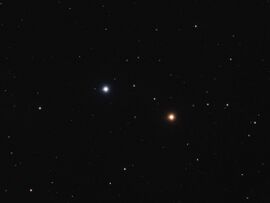Astronomy:Nu2 Boötis
Nu2 Boötis is a white-hued binary star[10] system in the northern constellation of Boötes. It is faintly visible to the naked eye with a combined apparent visual magnitude of 5.02.[2] Based upon an annual parallax shift of 7.86 mas as seen from the Earth,[1] it is located roughly 415 light years from the Sun. The system is moving closer to the Sun with a radial velocity of −16.6 km/s.[5]
This stellar pair have a nearly circular orbit with a period of nine years and a semimajor axis of 0.0615 arc seconds.[10] They are both of visual magnitude 5.80 and display a similar spectrum, with the primary, component A, being an A-type main sequence star with a stellar classification of A5 V.[4] This has been identified as an A-type shell star, suggesting there is a circumstellar disk of gas orbiting one or both stars.[11] There are two other stars that appear close to the pair, termed C and D, but they are physically unrelated.[12]
Ptolemy considered Nu2 Boötis to be shared by Hercules, and Bayer assigned it a designation in both constellations: Nu2 Boötis (ν2 Boo) and Psi2 Herculis (ψ2 Her). When the modern constellation boundaries were fixed in 1930, the latter designation dropped from use.[13]
References
- ↑ Jump up to: 1.0 1.1 1.2 1.3 1.4 1.5 1.6 1.7 1.8 Brown, A. G. A. (August 2018). "Gaia Data Release 2: Summary of the contents and survey properties". Astronomy & Astrophysics 616: A1. doi:10.1051/0004-6361/201833051. Bibcode: 2018A&A...616A...1G. Gaia DR2 record for this source at VizieR.
- ↑ Jump up to: 2.0 2.1 2.2 2.3 Johnson, H. L. et al. (1966), "UBVRIJKL photometry of the bright stars", Communications of the Lunar and Planetary Laboratory 4 (99): 99, Bibcode: 1966CoLPL...4...99J.
- ↑ Mason, B. D. et al. (2014), "The Washington Visual Double Star Catalog", The Astronomical Journal 122 (6): 3466–3471, doi:10.1086/323920, Bibcode: 2001AJ....122.3466M
- ↑ Jump up to: 4.0 4.1 Cowley, A. et al. (April 1969), "A study of the bright A stars. I. A catalogue of spectral classifications", Astronomical Journal 74: 375–406, doi:10.1086/110819, Bibcode: 1969AJ.....74..375C.
- ↑ Jump up to: 5.0 5.1 de Bruijne, J. H. J.; Eilers, A.-C. (October 2012), "Radial velocities for the HIPPARCOS-Gaia Hundred-Thousand-Proper-Motion project", Astronomy & Astrophysics 546: 14, doi:10.1051/0004-6361/201219219, A61, Bibcode: 2012A&A...546A..61D.
- ↑ Anderson, E.; Francis, Ch. (2012), "XHIP: An extended hipparcos compilation", Astronomy Letters 38 (5): 331, doi:10.1134/S1063773712050015, Bibcode: 2012AstL...38..331A.
- ↑ Hartkopf, W. I. et al. (June 30, 2006), Sixth Catalog of Orbits of Visual Binary Stars, United States Naval Observatory, http://www.usno.navy.mil/USNO/astrometry/optical-IR-prod/wds/orb6, retrieved 2017-09-13.
- ↑ Jump up to: 8.0 8.1 Zorec, J.; Royer, F. (2012), "Rotational velocities of A-type stars. IV. Evolution of rotational velocities", Astronomy & Astrophysics 537: A120, doi:10.1051/0004-6361/201117691, Bibcode: 2012A&A...537A.120Z.
- ↑ "nu02 Boo". SIMBAD. Centre de données astronomiques de Strasbourg. http://simbad.u-strasbg.fr/simbad/sim-basic?Ident=nu02+Boo.
- ↑ Jump up to: 10.0 10.1 Eggleton, P. P.; Tokovinin, A. A. (September 2008), "A catalogue of multiplicity among bright stellar systems", Monthly Notices of the Royal Astronomical Society 389 (2): 869–879, doi:10.1111/j.1365-2966.2008.13596.x, Bibcode: 2008MNRAS.389..869E.
- ↑ Hauck, B.; Jaschek, C. (February 2000), "A-shell stars in the Geneva system", Astronomy and Astrophysics 354: 157–162, Bibcode: 2000A&A...354..157H.
- ↑ Hutter, D. J.; Tycner, C.; Zavala, R. T.; Benson, J. A.; Hummel, C. A.; Zirm, H. (2021). "Surveying the Bright Stars by Optical Interferometry. III. A Magnitude-limited Multiplicity Survey of Classical Be Stars". The Astrophysical Journal Supplement Series 257 (2): 69. doi:10.3847/1538-4365/ac23cb. Bibcode: 2021ApJS..257...69H.
- ↑ "Bayer's Uranometria and Bayer letters". http://www.ianridpath.com/startales/bayer.htm.
External links
- Hoffleit (1991), "HR 5774", Bright Star Catalogue, http://webviz.u-strasbg.fr/viz-bin/VizieR-S?HR%205774, retrieved 2017-09-13.
- "Nu2 Boötis", Aladin previewer (Centre de Données astronomiques de Strasbourg), http://aladin.u-strasbg.fr/AladinPreview?-c=15+31+46.9817%2B40+53+57.597&ident=CCDM+J15318%2B4054AB&submit=Aladin+previewer, retrieved 2017-09-12.
 |


